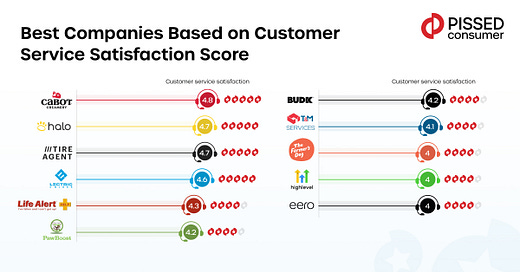Consumers Choice Depends on Actions, Not Promises
Great customer experience comes from consistent action—listening, fixing problems, and making improvements. That’s what really drives consumer choice.
Customer satisfaction doesn’t come from chance—it’s the result of deliberate choices. From support teams to service policies, the companies that win public recognition are those that take time to understand what customers expect, and then structure their operations to deliver on those expectations consistently.
Recent examples from brands recognized by the Consumers Choice Award by PissedConsumer 2025 for their high customer satisfaction show how consistent listening, proactive service, and thoughtful resolution strategies create long-term value for businesses and customers alike.
Responsiveness Built Into Operations
Fast service matters, but not without clarity. Brands like PriorityTire demonstrate that it’s not enough to respond quickly—you have to respond well. Their approach goes beyond scripted replies. The company focused on improving its response time and customer interaction by adding real-time chat support and closely monitoring service speed.
Their approach didn’t stop at tools—they also emphasized accountability. In one case, the company mediated a complex issue between a customer, a third-party platform, and an installer. Rather than assign blame or delay, they took on the responsibility of coordinating a resolution. The effort paid off in transforming a frustrating situation into a positive experience for the customer.
“This is our goal—to provide the highest level of service, no matter how challenging the circumstances.”
Empathy in Customer Interaction
The value of empathy in customer service is equally clear. Support Pets invests in a culture of care, empowerment, and continuous improvement. They doubled their Customer Experience team and introduced proactive outreach policies, where agents contact customers when delays are detected, instead of waiting for a complaint.
In one urgent case, a manager took the initiative to call a customer on his day off to resolve a billing issue that had real-life consequences. He stayed on the phone until the refund was confirmed. It was a moment of real human connection that left a lasting impression.
“When our customers face challenges, we’re right there beside them—listening, responding, and continuously evolving our services to ensure every interaction is as seamless, supportive, and reassuring as possible.”
Making Feedback Part of the Process
Feedback shouldn’t just be reviewed; it can also be integrated into the product lifecycle. At HighLevel, customers can submit feature requests and vote on suggestions, allowing them to directly influence the development roadmap. This process, along with 24/7 support and customized service tiers, turned feedback into a meaningful driver of product development. By giving users a say in how the platform evolves, the brand reinforces its commitment to transparency and user success.
“By actively engaging with customer feedback, we strengthen our relationships and reinforce the message that HighLevel is built with and for our customers.”
Why Consumer Choices Follow Consistent Effort
What all three brands have in common is a shift from reactive to proactive service. They don’t wait for complaints to pile up. Instead, they monitor patterns—slow deliveries, billing errors, miscommunication—and address them at the source. This reduces the number of issues and, importantly, builds long-term trust.
There are a few clear takeaways for businesses aiming to build stronger customer experiences:
Treat feedback as data. Don’t just respond—analyze trends, identify weak points, and fix processes at scale.
Give customer-facing teams the flexibility to solve problems. Rigid policies frustrate customers. Empowered agents can solve issues faster and more fairly.
Reach out before issues escalate. A proactive call or message often means the difference between a bad review and a loyal customer.
Transparency builds reputation. Let customers see how their input leads to real change. It validates their experience and strengthens loyalty.
Customers don’t expect perfection, but they do expect to be heard. When companies build systems that consistently support that expectation, trust grows, and with it, their reputation.
The best-performing brands aren’t just solving problems. They’re preventing them, learning from them, and keeping the door open for conversation. And that’s the real foundation of customer loyalty.





